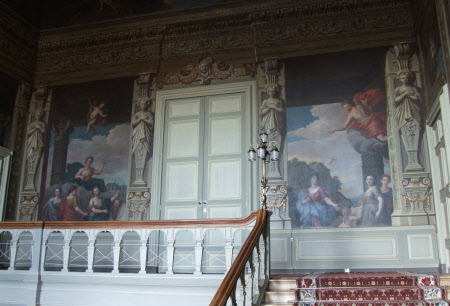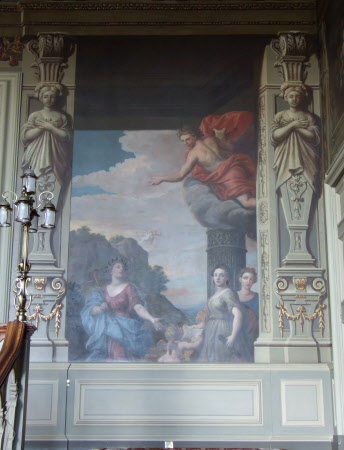(Left) Architecture: Venus and attendants, with Petworth House and plans within an architectural frame incorporating two caryatids (Right) Music: Apollo and attendants, within architectural frame incorporating two caryatids
Louis Laguerre (Versailles 1663 - London 1721)
Category
Art / Wall paintings
Date
1718 - 1720
Materials
Oil on plaster
Place of origin
Petworth House
Order this imageCollection
Petworth House and Park, West Sussex
NT 486596
Caption
This was one of Laguerre’s last painted scenes and was completed in 1720. It was painted at the same time as his masterpiece at Blenheim. A French painter, he came to England in 1683 and decorated the great houses of the nobility across England. The principal theme of the wall-painting is the story of Prometheus and Pandora. Having stolen fire from the gods, Jupiter chained Prometheus to a rock but he was released by Hercules. He then fashioned men from clay but as further punishment Jupiter caused Pandora to open a box which unleashed all the world’s evils but also hope. The choice of subject matter must be an allusion to the disastrous fire of 1714.
Summary
Oil painting on plaster, (Left) Architecture: Venus and attendants, with Petworth House and plans within an architectural frame incorporating two caryatids. (Right) Music: Apollo and attendants, within architectural frame incorporating two caryatids. The landing is painted with depictions of the Muses framed by pilaster with caryatids. First floor landing left of door: Venus and attendants, with Petworth House and plans within an architectural frame incorporating two caryatids. In the background is shown Petworth House as it was at the end of the 17th century, with the dome still surmounting it. In the right foreground a male figure displays a ground plan of Petworth House. To his left are three female dieties in classical robes, the one in the centre holds a plan of a dome in her left hand and points with her right at the ground-plan of Petworth House, the one on the right - Venus ? - also points with her right right at the plan of Petworth House and with her left points to Petworth House in the background, Above these figures on a cloud sits a female deity - Venus - also in a state of classical dishabille, with her left arm upraised holding a pair of compasses, a flying cupid above her. Is this Venus in the heavens and earth? The Duchess of Somerset’s triumphal car and her entourage are travelling through a pillared colonnade which also appears in the adjacent painting over the door and which continues into this painting. Presumably it was Laguerre’s fanciful conceit that the triumphal car would eventually arrive at this panel. It is noted that the capitals of the pillared colonnade are Composite i.e. Corinthian/Ionic with embellishments and, as the usual practice was for Corinthian capitals to be used for temples of Venus, Flora, Proserpine and Water Nymphs, it could be surmised that the Goddess on the cloud with the pair of compasses is Venus, as is the figure (come down to earth) pointing to the House and the plan. First floor landing right of door: Music - Apollo and attendants, within architectural frame incorporating two caryatids In a mountainous landscape (the Muses had their abode on mountains, particularly Helicon (near Ascra), in Boeotia and Pieria near Mount Olympus), the Muse of Music, Euterpe, stands left, holding an aulos in her right hand and looking up at Apollo (the God of Music - the Muses were directly subordinate to him), floating on a cloud, above right, holding a lyre under his right arm and pointing with his left hand to a distant figure of Pegasus who was regarded as the horse of the Muses. Centre is a winged cupid handing a sheet of music to a young female attendant who holds it with her right hand and in her left, a violin (?), another female attendant stands behind her. Again this is a continuation of the colonnade which begins in the Triumph.
Provenance
By descent, until the death in 1952 of the 3rd Lord Leconfield, who had given Petworth to the National Trust in 1947, and whose nephew and heir, John Wyndham, 6th Lord Leconfield and 1st Lord Egremont (1920-72) arranged for the acceptance of the major portion of the collections at Petworth in lieu of death duties (the first ever such arrangement) in 1956 by H.M.Treasury.
Credit line
Petworth House, The Egremont Collection (acquired in lieu of tax by HM Treasury in 1956 and subsequently transferred to the National Trust)
Makers and roles
Louis Laguerre (Versailles 1663 - London 1721), artist

